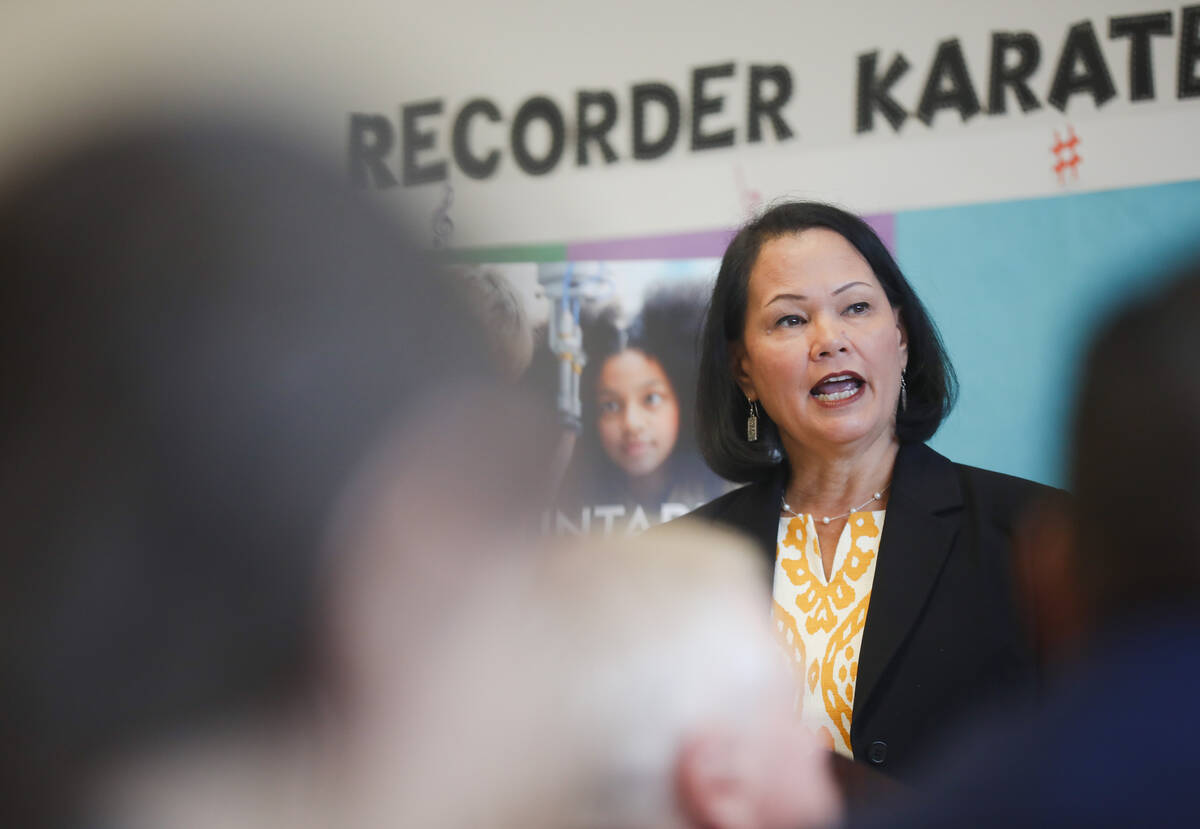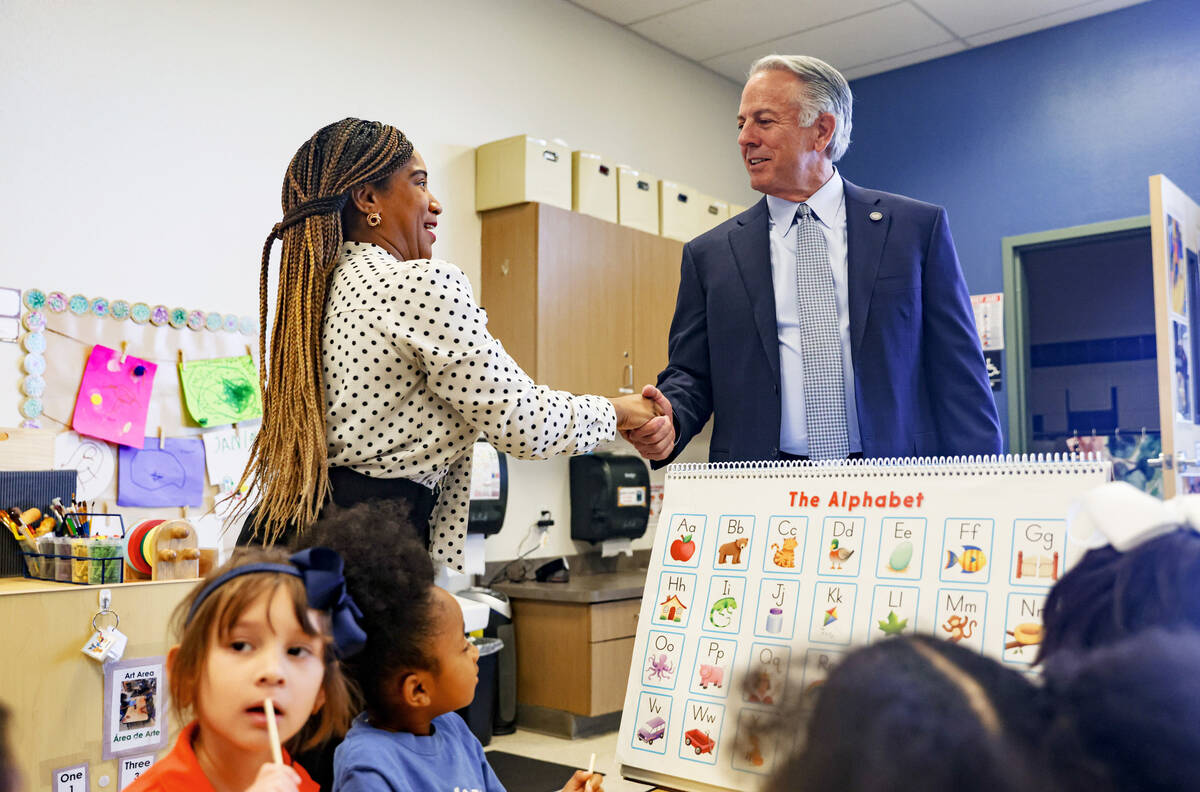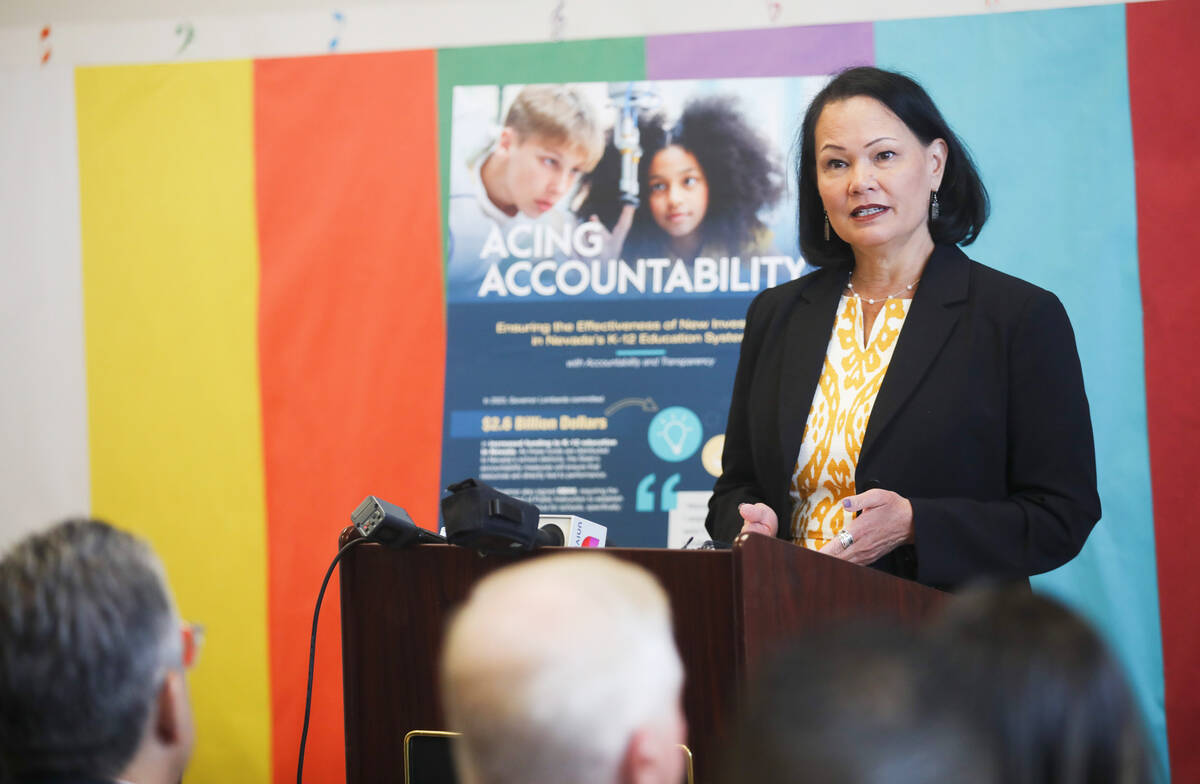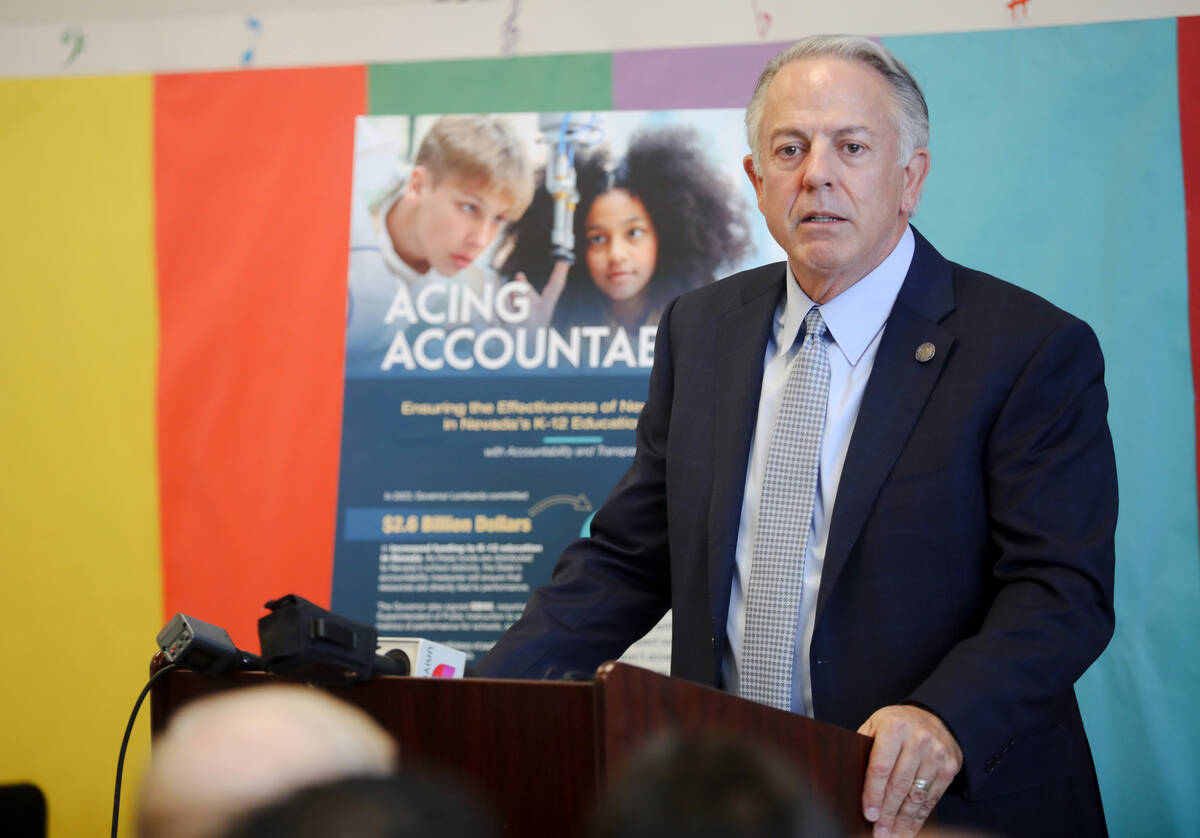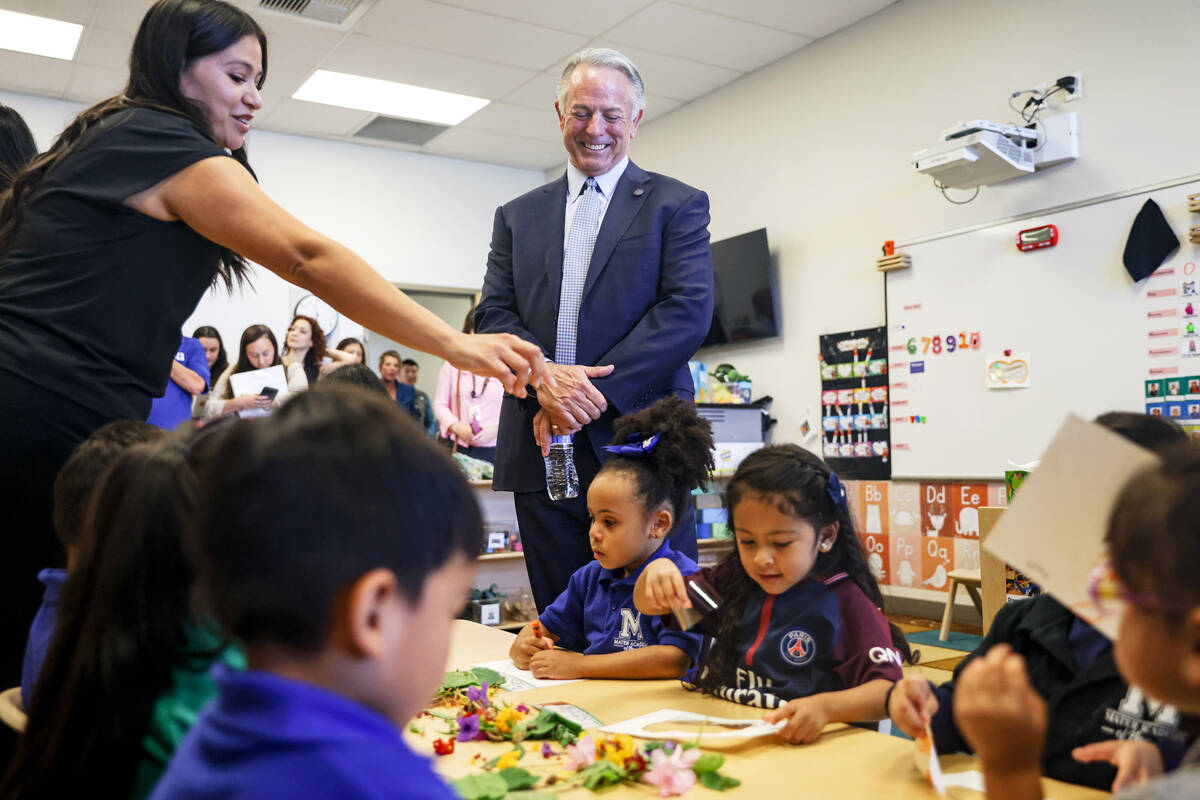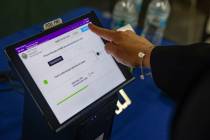‘Unprecedented accountability’: New school performance metrics unveiled
State officials announced Thursday they’re establishing new accountability metrics after appropriating an additional $2.6 billion in funding for K-12 public education over the next two years.
Gov. Joe Lombardo and State Superintendent of Public Instruction Jhone Ebert announced the “Acing Accountability” initiative during a news conference at Mater Academy Mountain Vista, a public charter school in Las Vegas.
Lombardo said he signed the largest education budget in the state’s history — totaling more than $12 billion over the biennium — like he pledged in his State of the State address in January. His remarks were met with applause from the audience.
“With this historic funding, however, comes unprecedented accountability,” he said.
Several bills during the legislative session called for the creation of accountability measures for the state’s 17 school districts and the Nevada State Public Charter School Authority.
One of them was Senate Bill 98, which requires the superintendent of public instruction to create performance metrics.
Districts will be measured on student outcomes for this school year and the 2024-25 school year.
A rubric will be used to determine whether a district is exceeding, meeting, approaching or failing to meet expectations for each metric.
The Nevada Department of Education will monitor and post yearly results. Districts will be assessed on six “essential questions” covering these topics:
— Effectively implementing reading and math resources
— Kindergarten through third grade literacy
— Fourth through eighth grade math
— High school graduates being prepared for college and careers
— A workforce that can meet student needs
— The use of innovative solutions
School districts and charter schools will also develop performance metrics that will be approved by the state.
Lombardo called it “an instrumental new accountability framework.”
The governor said that, as he stated in January, he expects results and won’t accept a lack of funding as an excuse for underperformance.
“This system is intended to measure how the increase in education funding will impact student achievement and district data,” he said.
The Clark County School District said in a statement Thursday that it welcomes Lombardo’s effort to provide “measures of academic progress” across the state.
The district said many of the measures align with goals already outlined in the district’s five-year strategic plan.
“Starting in the classroom, CCSD staff continue to focus on student-centered instruction and outcomes to lift our students out of the pandemic-related declines we — like every school district — have experienced,” Superintendent Jesus Jara said in the release. “Those who criticize our results must realize they are criticizing our teachers who deal with unprecedented issues to educate our kids, including the ongoing effects of a worldwide pandemic.”
Lombardo said that state officials believe that by investing money in schools, and intentionally focusing on systems, processes and results, it can improve student achievement and educator effectiveness.
He said there’s a responsibility to do the absolute best for Nevada’s children. “I won’t accept anything less.”
Following the news conference Thursday, Lombardo and Ebert toured preschool classrooms at Mater Academy Mountain Vista.
In one classroom, students worked on a nature project where they attached foliage and flowers to a pumpkin cutout. Down the hallway, students used Bingo cards to identify colors and shapes such as a black diamond and white triangle.
Which metrics will be used?
Literacy growth and proficiency for kindergarten through third grades will be gauged using the Measures of Academic Progress (MAP) assessment.
For fourth through eighth grade math, growth and proficiency will be measured using results on the Smarter Balanced standardized test students take in the spring.
For college and career readiness, one goal is for at least 75 percent of high school students to enroll for the 2024-25 school year in at least one class needed to meet the state’s requirements for a college and career ready diploma.
The workforce metric includes a requirement for showing at least a 20 percent decrease in the number of unfilled positions — which includes those temporarily filled by a substitute — or having at least 95 percent of classrooms with a licensed educator teaching in their endorsed area.
“A highly effective educator has the power each and every day to change our children’s lives,” Ebert said.
Districts must also meet additional metrics meant to reduce the gap between the percentage of long-term substitutes and vacancies at Title 1 schools — those with a high poverty rate — compared with others in the district.
After the presentation, Peter Guzman — president of the Latin Chamber of Commerce — asked if the superintendents or the union can “screw this up.” The question was met with laughter in the audience.
The elephant in the room is what happens if a district doesn’t meet the metrics and if there’s any recourse, Lombardo said.
Unfortunately, state law is void of that language, he said, but added there’s full intent to develop those tools to present at the next legislative session.
Lombardo said that in the meantime, the conversation about school choice also needs to continue.
Where data is today is not acceptable and there’s a need to move now, Ebert said.
Children are phenomenal human beings who have the capacity to learn and demonstrate their skill set at a much higher level, she said.
CCSD, CCEA responses
With state-established metrics, the district will “continue rebounding our students to produce improved outcomes,” the district said.
It also noted the district has “increased academic rigor and pacing to combat educational impacts following the pandemic and expects to show improvement on these standards in the current school year.”
The district said the school board and superintendent are ultimately accountable for results, but “accountability expectations must exist at every level” and the district will work with employee bargaining units to ensure every employee understands the expectations.
Also on Thursday, Jara visited Rundle Elementary School in Las Vegas with Ebert to see how state funding is being used to improve early childhood development.
The Clark County Education Association — a teachers union that represents about 18,000 licensed employees — said in a statement Thursday that it supports Lombardo’s efforts to impose accountability standards.
But CCEA said it has “no confidence” in Superintendent Jesus Jara or the school board to “live up to this standard for improved student outcomes.”
The union said it is clear that Jara has “gone rogue” and hasn’t listened to the demands for accountability from the governor or legislative leadership in the past.
The union said it will do its part to hold the school district accountable and “expose misleading reports” that Jara may issue.
It also said it believes stronger measures such as receivership are needed in the district.
“We believe direct intervention like receivership should occur — removing the CCSD administration and replacing it with an interim administration by the Superintendent of Public Instruction to ensure that student outcomes improve and the historic funding levels passed this past legislative session find their way into the classroom,” the union said.
Last week, the district declared an impasse in collective bargaining with the teachers union after 11 negotiation sessions since late March.
Contact Julie Wootton-Greener at jgreener@reviewjournal.com or 702-387-2921. Follow @julieswootton on X.





